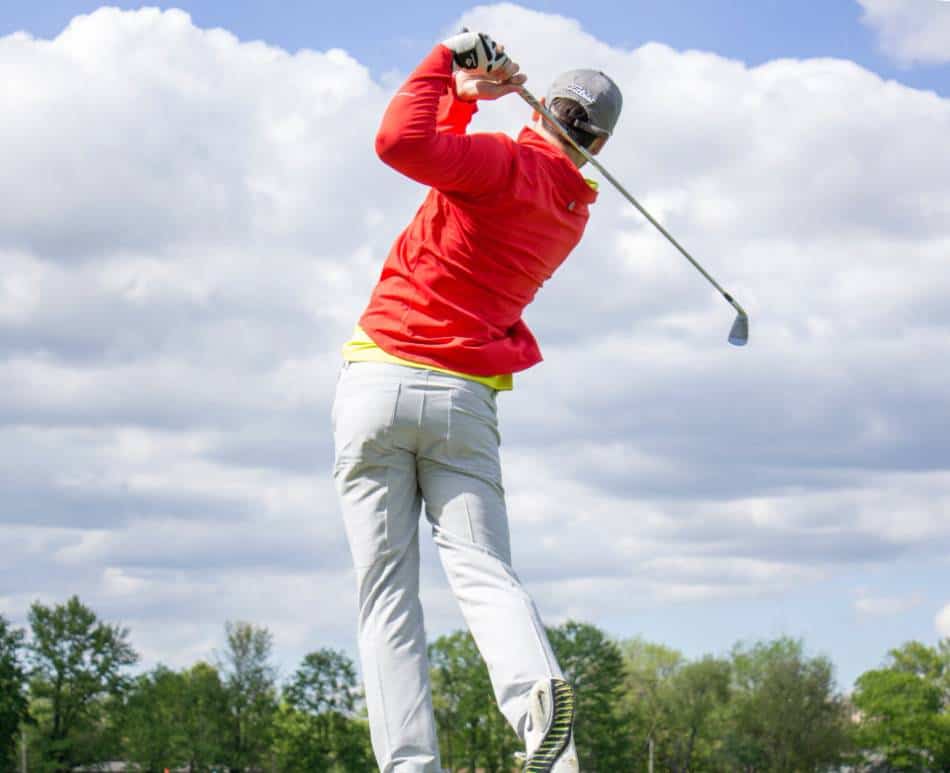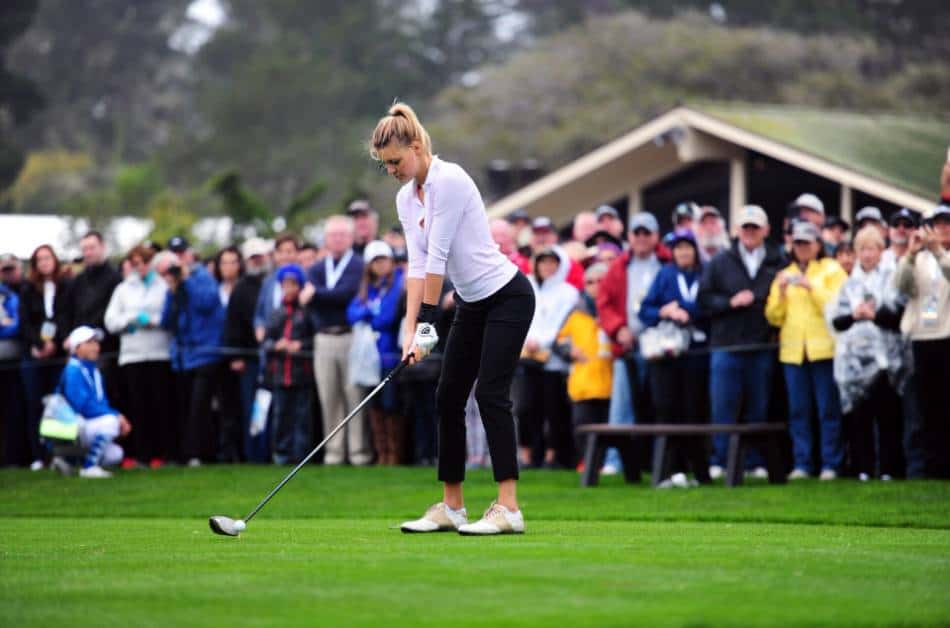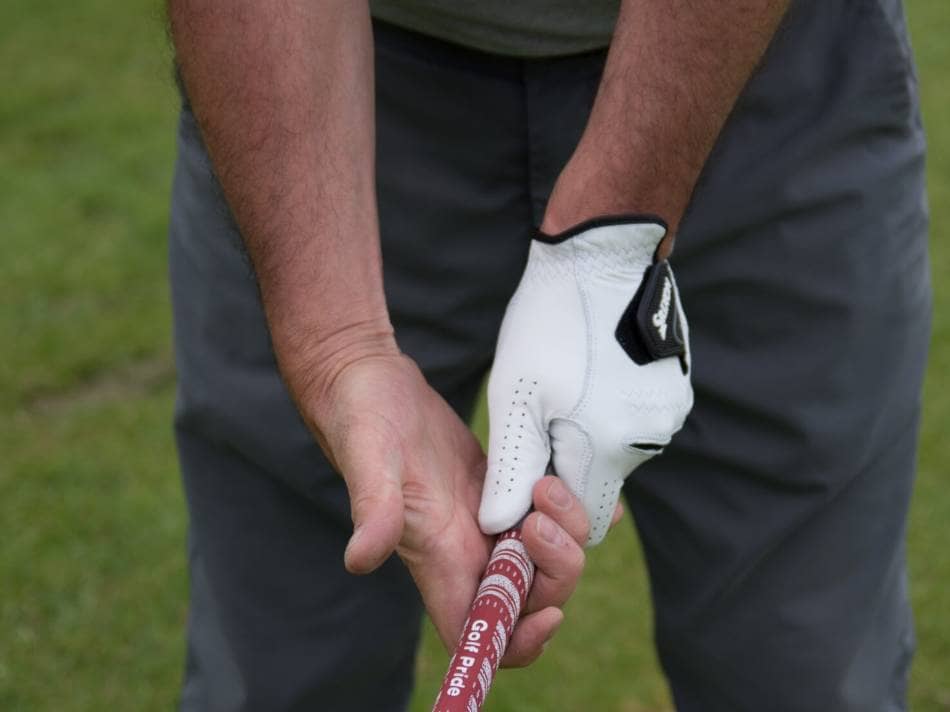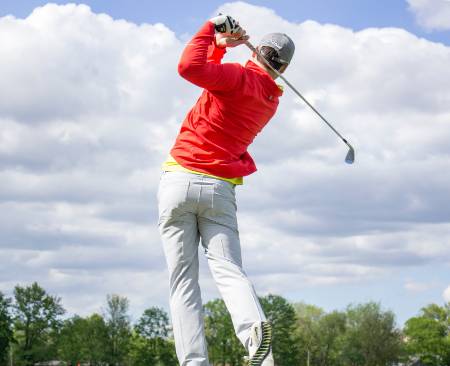
Golf is a game that has plenty of ups and downs and is oftentimes as much mental as it is physical. However, players who struggle with their game have inevitably received a suggestion to adjust their grip, as it might have been too strong.
So, what is a strong grip in golf?
A strong grip is when a player moves their left hand (right hand for lefties) on the grip so that more of the knuckles on their hand are visible when looking down the club shaft. Players who struggle to get the clubhead through the ball would benefit from a stronger grip for a variety of reasons.
Throughout this article, we’ll dive into those reasons and see how a strong grip compares to neutral and weak grips. Stick around, because you won’t want to miss out!
Is a Strong Grip Good?
Golfers all have their own struggles with their game, so a strong grip cannot be universally recommended for everyone. However, for specific issues, a strong grip can be very beneficial for golfers.
Right-handed players who tend to miss the ball to the right, as well as left-handed players who tend to miss the ball left, could potentially benefit from a stronger grip as a stronger grip can reduce these errors.
Often, this type of miss is common among newer golfers, but also among players who tend to try to play a fade, which is a left to right ball movement for right-handed players and the opposite for left-handers.
It is important to note that there are a lot of variables that go into a golfer hitting a slice, which is similar to a fade with more ball movement, which happens when the clubface doesn’t turn over at impact.
A stronger grip could benefit players who are struggling with a slice or a block, however without a full picture of the player’s swing it is difficult to definitively say that a strong grip should be taken into account.
A couple of examples that could lead to a slice or a block include the player’s alignment, swing path, and follow-through. Most of these issues are much longer processes to fix than a simple grip adjustment, so many golfers will begin their swing tinkering by trying to adjust their grip strength.
This type of quicker fix could be made mid-round to ease some of the struggles the player is having getting through the ball, and other issues could be identified later through practice or observation from an outside party.
Strong Grip Ball Position
Players who use a strong grip will be trying to hit more of a draw, which is a slight right to left ball flight for right-handed players and the opposite for left-handers. Either way, a player who is using this type of grip would do well to note some additional factors that can impact the flight of the ball.
The first thing to note when strengthening the grip is where the golf ball is located in relation to where the golfer is standing. In a forward stance, the golf ball sits towards the front foot of the player.
A forward stance helps to accentuate the head of the golf club, helping to get the swing through the golf ball at impact, which is exactly what a strong grip is supposed to do a. In addition, a ball forward in a player’s stance will fly higher than it usually does in its standard position.
If a strong grip is not moving the ball as much as you need it to, a forward ball position can help. Be sure to note where the club you are hitting is normally meant to be played in your stance.
Players who are looking to minimize the draw or hook that their strong grip is creating would look to move the ball to the back of their stance, or towards their back foot. This not only slows the clubhead from getting through the ball but also helps hit the ball a little further and a little lower.
The distance that the player is standing away from the golf ball also impacts the flight of the ball. Standing too close to the ball is more likely to cause a player to hit a slice, whereas standing too far away promotes a hook.
This is another area of a player’s setup to check after deciding to strengthen the grip, as standing too close with a strong grip will act against the player’s intentions.
Do Pros Use a Strong Grip?

The short answer is yes. Pro golfers practice the sport in the same general way like the rest of us. If they swing a club with a strong grip, it has the same general effects as if you or I use a stronger grip. Many professionals tinker with their swing just like casual players do.
An in-depth article about various grips used by professional players can be found here. PGA Tour golfers use a wide variety of grips, and some even use one type of grip with one of their hands and a different type of grip with the other.
Each player is unique, and sadly, there is no secret solution that makes anyone magically play better golf but using a strong grip is certainly prevalent.
How Do I Get a Stronger Grip?
The easiest way to strengthen your grip is to look at your current grip and just move your top hand (closest to the butt of the club) so that your thumb is off-center from the center of the shaft. To make it a strong grip, make sure that you can see more knuckles on your top hand than you could before moving it.
Alternatively, you can also strengthen your grip by moving your bottom hand (closest to the clubhead) so that you see fewer knuckles. Both types of grip adjustments will make you more inclined to swing the clubhead through the ball, which helps prevent a slice.
It’s worth noting that grip adjustments often feel uncomfortable at first. Making any adjustment to your swing is going to take some time to adjust. Grip changes are no different; it is important to be patient with yourself as you develop new habits that will pay off for your game in the long run.
Adjusting your grip is also not always as easy as it seems. Due to the grip being the only point of contact between the body and the golf club, a lot of the results of a swing can be tied back to the grip. A small adjustment in the position of even one hand on the club can drastically alter the club’s face at impact.
A permanent grip adjustment is a long-term swing project and can require just as much time and practice as any other major revamp of a player’s swing. As much as your practice implementing a stronger grip though, there is no perfect solution to your swing and it’s important to be flexible.
Some days on the course may warrant a stronger grip than other days just based on the results you’re seeing.
Strong Grip vs. Neutral Grip

When a player has what is described as a neutral grip, their hands are centered on the club grip. The most effective way to find a neutral grip is to set the golf club down on the course so that the clubhead sits square. Then, the player should grab the club with both thumbs pointed directly down the club shaft in a straight line.
The easiest way to distinguish between strong grips and weak grips is to compare them to a neutral grip. The strong grip simply takes the hands (or just one hand, depending on the player) and turns them clockwise on the grip from the neutral grip for a right-handed player.
A left-handed player would turn their hands counterclockwise on the grip to create a strong grip. Another way to envision a strong grip is to grab the club with an already closed club face, although I would not recommend using this as a standard practice or pre shot routine for setting your grip.
A strong grip will help the club face and clubhead get through the golf ball easier, which in turn leads to players reducing a slice. A player who is utilizing a strong grip will tend to turn the clubhead through the ball, which can lead to a hook if the player flips their hands at impact or has strengthened their grip too much. As previously mentioned, there are many aspects of the swing that lead to the actual outcome of the shot. Players should note results before committing long-term to using a strong grip.
Strong Grip vs. Weak Grip
A player who is utilizing a strong grip will have moved their hands clockwise from a neutral grip if they are right-handed, where the thumbs are pointed straight down the club shaft. In contrast, a weak grip occurs when the right-handed player moves their hands counterclockwise from the neutral position.
A left-handed player who moves their grip clockwise is using a weak grip, whereas counterclockwise is a strong grip for a left-handed player.
The weak grip can also be thought of as grabbing the club with an open club face. This grip makes the club more difficult to get through with strong contact, often leading to a slice if other aspects of the swing don’t help the club face catch up. Players who often miss with a hook or a pull can use a weaker grip to attempt to correct this type of miss.
Opposite approaches to holding the club come with strengths and weaknesses. Players need to be aware of their tendencies to make proper grip adjustments. Utilizing a non-neutral grip should be an adjustment that comes with time and experience.
It is also worth noting that players can use different grip styles that are not contingent on the strength or weakness of their grip. These grips can be classified as the baseball (10 fingers) grip, interlock grip, and overlap grip.
These grip types are relevant because most new players use a 10-finger grip. When this occurs, the hands can work independently of one another and lead to conflicting actions during the swing.
Especially if one hand is strong and the other is weak, players could see no correction in their ball’s flight and possibly even feel the club grip twist in opposite directions since each hand is independent.
Not every player needs to adjust to an interlock or overlap grip. For example, Scott Piercy on the PGA Tour won the Canadian Open back in 2012 with a 10-finger grip.
Is a Strong Grip or Weak Grip Better?
Players utilize a strong grip or a weak grip for a variety of reasons. Neither grip is necessarily better or worse than each other independent of other factors. A strong or weak grip could easily be better than the other for an individual player.
A golfer who is looking to compensate for a frequent slice or push would be better off utilizing a stronger grip. By contrast, a golfer who is looking to compensate for frequent hooks or pulls should look to utilize a weaker grip. Whether a player finds a strong grip or a weak grip to be better depends on what type of issue the player is having with their swing.
In addition to the grip, a player’s alignment and swing path also have a major impact on the ball flight for each swing. The golf swing is a complicated and compound motion. Players should look to examine their swing as a whole whenever possible instead of just relying upon grip changes to correct swing errors.
It’s worth noting that grip adjustments aren’t always just for correcting major swing issues. At higher levels of golf, players can hit either a slice or hook (this could also be a draw or fade if the ball movement is less drastic) upon command according to course conditions.
A grip adjustment can be one of the easiest ways to create a desired ball flight and players may go back and forth between stronger and weaker grips depending on what type of shot they need to execute on the course.
When there is situational demand for a draw or fade, a strong grip or weak grip can be better than the other, depending on the player. Dogleg left holes will command a draw or hook off the tee for a right-handed player, in which case a strong grip would be better.
A left-handed player in the same scenario would benefit from a weak grip, as they’ll want to hit a fade or slice around a dogleg left.
A dogleg right hole, by contrast, moves in the opposite direction. A right-handed player ideally would utilize a weaker grip to try to work a fade around the dogleg (or a slice, depending on the severity of the dogleg). A left-handed player on a dogleg right hole will want to use a stronger grip to hit a draw or hook.
High-level players can make these types of adjustments on the fly during a round and still be able to return to their conventional grip style. This type of versatility is a key goal to aim for in the development of one’s game.
In this course and shot-specific scenario exists the only definitive time when one type of grip would be superior, and that is only because of each grip’s tendency to help direct a player towards a certain type of shot shape that can be of immediate help to the player.
The Different Types of Golf Grips

There are a few different ways that golf grips can be broken down. The first manner is the direction in which the hands point down the club shaft. More specifically, if the thumbs are straight down the club shaft, that is considered a neutral grip.
When a player’s hands are turned clockwise from this neutral grip, that is considered to be a strong grip for a right-handed player or a weak grip for a left-handed player. In contrast, moving the hands counterclockwise creates a weak grip for a right-handed player or a strong grip for a left-handed player.
Golfers can utilize any of the three varieties of grip. Players can adjust just one hand or both hands to create a strong or weak grip, and there is the occasional player who will create a strong grip with one hand and a weak grip with the other intentionally. The grip is a very personal preference for players and there is no definite solution as to what will work for each golfer.
Each grip variation can also be used on the course to try to adapt a shot to work a certain way on command. Players can vary their grip type to hit a certain type of shot to shape their ball flight depending on the course in front of them.
There are also some variations in the manner in which a player’s hands sit on the grip and those different types of grip can affect how the hands interact with one another during a swing.
For example, a player who uses a 10-finger grip or a baseball grip will simply put their hands on top of one another separately. Each hand sits independent of one another, but they generally are next to one another on the grip and not spread apart.
Then, there is the interlocking grip, where the player links the index finger on the high hand of the grip to the pinky finger on the low hand of the grip. Variations exist of this grip with more than just these two fingers wrapped around one another, but this is the most common and basic version of an interlock.
Interlocking helps to force the hands to move as one unit within the swing, which helps them to consistently support one another in whatever action is trying to be taken.
Finally, there is an overlapping grip. The overlap is common in putting but is also used elsewhere by many players. In an overlapping grip, the player extends at least the index finger of the hand higher on the grip to lie on the back of their lower hand.
Again, there are variations where multiple fingers can overlap, but the single index finger is the most basic and common overlap grip. An overlap helps the hands move together like in an interlocking grip, but does not require the player to link their fingers together, which some players find uncomfortable and impractical to use in their swing.
A strong, neutral, or weak grip coexists with a player’s 10-finger, interlock, or overlap grip. Regardless of how a player puts their fingers on the grip, they can utilize a strong, neutral, or weak grip.
Players need to make a decision on each grip variation independently, as well as try different types of grips on the range to get a better understanding of how each grip variation affects their swing.
There are a lot of other grip factors in addition to the setup of the hands and where the thumbs sit. For example, grip strength can have a huge impact on the swing. If the club is gripped too tightly, it cannot rotate properly and it makes the clubface more difficult to get through impact at the proper speed.
Clubs also need to be gripped at the proper height. It’s important to make sure that your clubs are the proper length so that the hands can sit at the proper distance from the ground.
The grip in a golf swing is a center point of focus when it comes to swing errors. As the only point where a player touches the club, the grip has an immense impact on the swing and ball flight. A strong grip can be a valuable tool for a player given the right circumstances.
